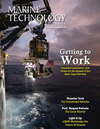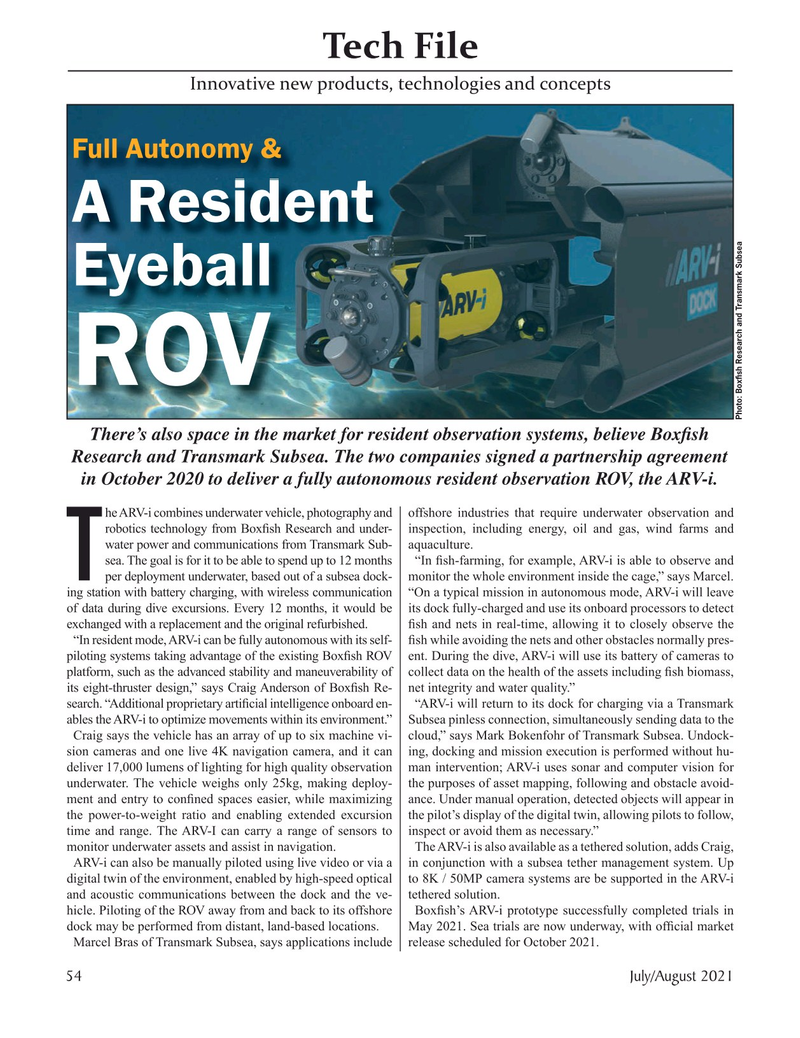
Page 54: of Marine Technology Magazine (July 2021)
Autonomous Vehicle Operations
Read this page in Pdf, Flash or Html5 edition of July 2021 Marine Technology Magazine
Tech File
Innovative new products, technologies and concepts
Full Autonomy &
A Resident
Eyeball
ROV
Photo: Box? sh Research and Transmark Subsea
There’s also space in the market for resident observation systems, believe Box? sh
Research and Transmark Subsea. The two companies signed a partnership agreement in October 2020 to deliver a fully autonomous resident observation ROV, the ARV-i. he ARV-i combines underwater vehicle, photography and offshore industries that require underwater observation and robotics technology from Box? sh Research and under- inspection, including energy, oil and gas, wind farms and water power and communications from Transmark Sub- aquaculture. sea. The goal is for it to be able to spend up to 12 months “In ? sh-farming, for example, ARV-i is able to observe and
T per deployment underwater, based out of a subsea dock- monitor the whole environment inside the cage,” says Marcel. ing station with battery charging, with wireless communication “On a typical mission in autonomous mode, ARV-i will leave of data during dive excursions. Every 12 months, it would be its dock fully-charged and use its onboard processors to detect exchanged with a replacement and the original refurbished. ? sh and nets in real-time, allowing it to closely observe the “In resident mode, ARV-i can be fully autonomous with its self- ? sh while avoiding the nets and other obstacles normally pres- piloting systems taking advantage of the existing Box? sh ROV ent. During the dive, ARV-i will use its battery of cameras to platform, such as the advanced stability and maneuverability of collect data on the health of the assets including ? sh biomass, its eight-thruster design,” says Craig Anderson of Box? sh Re- net integrity and water quality.” search. “Additional proprietary arti? cial intelligence onboard en- “ARV-i will return to its dock for charging via a Transmark ables the ARV-i to optimize movements within its environment.” Subsea pinless connection, simultaneously sending data to the
Craig says the vehicle has an array of up to six machine vi- cloud,” says Mark Bokenfohr of Transmark Subsea. Undock- sion cameras and one live 4K navigation camera, and it can ing, docking and mission execution is performed without hu- deliver 17,000 lumens of lighting for high quality observation man intervention; ARV-i uses sonar and computer vision for underwater. The vehicle weighs only 25kg, making deploy- the purposes of asset mapping, following and obstacle avoid- ment and entry to con? ned spaces easier, while maximizing ance. Under manual operation, detected objects will appear in the power-to-weight ratio and enabling extended excursion the pilot’s display of the digital twin, allowing pilots to follow, time and range. The ARV-I can carry a range of sensors to inspect or avoid them as necessary.” monitor underwater assets and assist in navigation. The ARV-i is also available as a tethered solution, adds Craig,
ARV-i can also be manually piloted using live video or via a in conjunction with a subsea tether management system. Up digital twin of the environment, enabled by high-speed optical to 8K / 50MP camera systems are be supported in the ARV-i and acoustic communications between the dock and the ve- tethered solution.
hicle. Piloting of the ROV away from and back to its offshore Box? sh’s ARV-i prototype successfully completed trials in dock may be performed from distant, land-based locations. May 2021. Sea trials are now underway, with of? cial market
Marcel Bras of Transmark Subsea, says applications include release scheduled for October 2021.
54 July/August 2021
MTR #5 (50-63).indd 54 7/30/2021 9:34:01 AM

 53
53

 55
55
